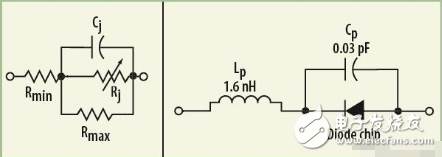In high-precision test instruments like vector network analyzers, expensive mechanical switches have proven to be a reliable choice. However, for mass-produced consumer products such as cable or satellite TV (CATV/SATV) transmission systems, cost-effective electronic switches are more suitable. These switches typically use transistors or PIN diodes. Unlike mechanical switches, semiconductor-based switches have no moving parts, which leads to faster response times and longer operational life.
PIN diodes are widely used in single-pole, single-throw (SPST) and single-pole, multi-throw switching applications. They function as variable resistors for signals with frequencies significantly higher than the diode's cutoff frequency (fc), usually above ten times fc.
By applying a forward bias current, the junction resistance of the PIN diode (Rj) can be adjusted from a high impedance state to a low resistance state. This makes PIN diodes versatile, as they can be used in both series and parallel switching configurations. The insertion loss (A) for a series switch is given by:

When connected in parallel, the insertion loss formula becomes:

Here, Zo represents the characteristic impedance of the system, commonly 50 or 75 Ω in RF applications.
The design of a selector switch involves balancing bandwidth and isolation requirements. While series switches offer low insertion loss over a wide frequency range, they provide less isolation. On the other hand, parallel switches are often combined with 1/4 wavelength transmission lines, which are narrowband but offer better isolation.
Both test equipment and CATV/SATV systems require RF switches that operate across multiple octaves with minimal signal loss. In environments with multiple carriers, such as CATV/SATV, switches must maintain high linearity to avoid distortion and inter-channel interference, which can degrade signal quality.
To enhance isolation, multiple PIN diodes can be connected in series. This configuration allows them to share the same bias current, reducing power consumption. Double-ended components like PIN diodes are also easier to cascade compared to three-terminal transistors, which require separate control circuits for each additional component.
Body Effect Diode vs. Epitaxial Growth Type PIN Diode
Designers should understand the differences between body effect and epitaxial (Epi) PIN diodes, as their construction methods lead to significant variations in RF performance. Body effect diodes have a low doping density and require a high bias current to conduct, making them unsuitable for battery-powered devices. Their thick intrinsic layer results in a long carrier lifetime (300–3000 ns), which helps reduce distortion in switch and attenuator applications.
In contrast, Epi PIN diodes have a highly doped intrinsic layer, making them ideal for low-current RF switching in compact devices. However, their shorter carrier lifetime (5–300 ns) leads to worse linearity, especially at low bias currents. This limits their use in applications like attenuators where high linearity is essential.
The performance of a PIN switch is also affected by its relationship to the diode’s cutoff frequency. Below 10 times the cutoff frequency, the diode no longer behaves as a resistor. Instead, it may act as an inductor or capacitor, leading to unpredictable behavior. When the frequency drops much lower than the cutoff frequency, the PIN junction behaves like a traditional PN junction.

In general, body effect diodes can operate at lower frequencies due to their thicker intrinsic layer, while Epi diodes are better suited for higher-frequency applications.
PIN Diode Model
Parasitic elements such as inductors and capacitors in the diode chip and package affect switching performance. In a series switch configuration, these parasitics cause a gradual decrease in isolation with increasing frequency. The package inductance also increases insertion loss proportionally with frequency.

To improve microwave performance, manufacturers are continuously developing smaller packages with fewer parasitics. Standard packages like SOT323, SOD-323, and SOD-523 reflect the industry's effort to produce low-cost, plastic-packaged PIN diodes.
Unfortunately, SPICE software, widely used in circuit design, cannot accurately model PIN diodes because it lacks parameters for minority carrier lifetime. A basic linear model of a PIN diode includes two resistors, a variable resistor, and a capacitor, as shown in Figure 1.
ZHOUSHAN JIAERLING METER CO.,LTD , https://www.zsjrlmeter.com